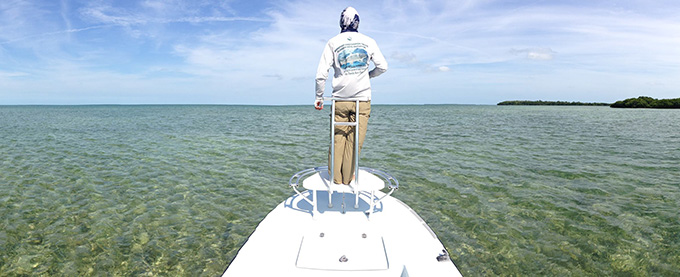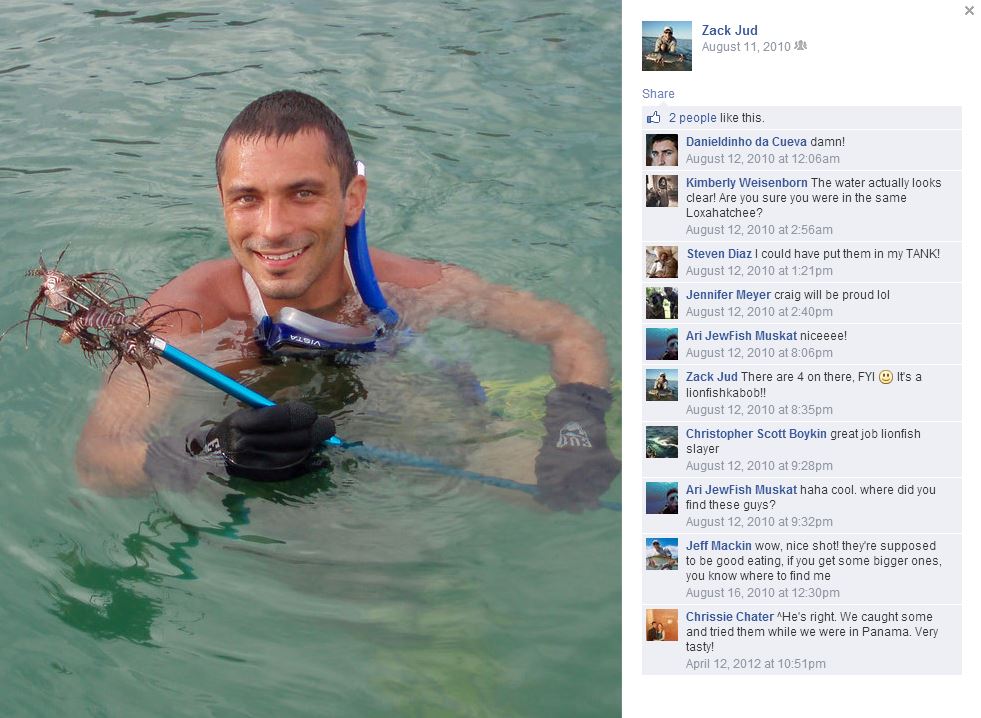
Was Lionfish Research Hijacked by 12-Year Old from Palm Beach Florida?
A month following the announced lionfish ban in Florida, a 12-year-old south Florida girl accredited for breakthrough in lionfish research; mistaken accreditation, or plagiarism?
Over the years, research regarding the invasive lionfish has been taking place, and in June 2014, Palm Beach resident, Lauren Arrington, is in the spotlight. Arrington presented a science fair project based on Dr. Zack Jud's previously published discovery of lionfish living in low-salinity estuarine habitats. Her story has been picked up nationally by CBS, NPR, CORAL magazine, and several educational websites, and has received almost 90,000 likes on Facebook, yet Jud's years of groundbreaking work on estuarine lionfish are being completely and intentionally ignored.
Several sources seem to immediately discredit Arrington's claim:
- Estuaries Poster [estuaries.org] – August 2010
- Predatory lionfish found in Loxahatchee River [palmbeachpost.com] – September 2010
- FIU researchers find predator in troubling waters [fiu.edu] – June 2011
- Recent invasion of a Florida estuarine system by lionfish† [ncsu.edu] – June 2011
- Battling the invasion of the lionfish [themiamiplanet.org] – November 2011
- Lionfish are in South Florida waters for keeps [sun-sentinel.com] – December 2011
- Site fidelity and movement patterns of invasive lionfish in a Florida estuary†† [fiu.edu] – February 2012
- Taming the lionfish [floridaweekly.com] – August 2012
- Florida declares war on invasive lionfish [reefbuilders.com] – August 2012
- Broad salinity tolerance in the invasive lionfish may facilitate estuarine colonization [ncsu.edu] – October 2013
- Environmental Biology of Fishes Journal [springer.com] – February 2014
- Anthropogenic Disturbances in Estuarine Ecosystems: The Effects of Altered Freshwater Inflow, Introduction of Invasive Species, and Habitat Alteration in the Loxahatchee River, FL‡ [fiu.edu] – March 2014
† D. Albrey Arrington, the father of Lauren Arrington, appears as an author on this paper released June 2011. He had absolutely nothing to do with the research however, he was clearly aware that lionfish were found in low salinity parts of the estuary years before the science fair project was carried out. By this time, Jud had planned on running salinity tolerance trials for quite a while before Arrington executed her project, invalidating the premise that any related research had been ultimately replicated or expanded upon by ecologists. Jud's work further revealed wild lionfish in salinities in as low as 8 ppt, just a hair above the young girls 6 ppt “breakthrough” in captivity.
†† A subsequent paper that Jud and his PhD advisor, North Carolina State University ecologist Craig Layman published in 2012 that documented movement patterns of lionfish within the estuary. The “discovery” was made years before the science fair project was carried out. Arrington's project lowered the salinity bar from 8 ppt (Jud's previous finding, which Arrington knew about) to 6 ppt. Jud subsequently demonstrated that lionfish could survive in salinities as low as 5 ppt for extended periods of time, and as low as 1 ppt for brief periods (in the wild, around low tide during the wet season).
‡ This research paper reflects a prior 19-month study on the effects of lower salinity on invasive species including the lionfish.
The above photo pulled from Jud's Facebook page, was taken in August 2010 when Jud first discovered lionfish occupying estuarine habitats – 3 years prior to Arrington's “discovery”.
My lionfish research is going viral…but my name has been intentionally left out of the stories, replaced by the name of the 12-year-old daughter of my former supervisor's best friend. I feel like my hands are tied. Anything I say will come off as an attempt to steal a little girl's thunder, but it's unethical for her and her father to continue to claim the discovery of lionfish in estuaries as her own.
– Marine Biologist, Zack Jud, Ph.D.
Jud, thrilled that his work has sparked the interest of Arrington, has no desire to diminish her curiosity or enthusiasm. He spends a massive amount of time exposing kids to science, and is pleased that she chose to focus on lionfish for her science fair project. However, encouraging the perpetuation of an outright lie is wrong no matter how you look at it. There are certainly better ways to parent and introduce a youngster to a career in the sciences.
CBS provided us with this video from their original coverage. It is important to note what is stated around the 1:26 mark, where reporter Vicente Arenas asks Albrey, “So no one knew lionfish were a threat to rivers like this one?”, to which Albrey responded, “They didn't. We certainly did not understand that. Lauren's research showed they are”. However, according to this estuaries poster dated 2012 on which Albrey Arrington's name appears as a co-author, it would seem as though this is clearly not the case, citing “We initially identified lionfish in the Loxahatchee River estuary (Jupiter, FL) in August 2010. This was the first documented estuarine intrusion of lionfish in the western Atlantic or Caribbean.” Lauren's on-air segment begins at the time index of 2:15.
Jud went on to disclose that although he did include Lauren Arrington in the acknowledgements section, that there is now a petition online demanding that Arrington's name be added as an author to Jud's most recent scientific publication. Jud's name has been excluded from all media, the viral photos, articles, and even the petition. Certainly, headlines like “Little girl's science fair project gives scientists great new idea” do not help the situation.
Regarding an article on Society for Science written by Bethany Brookshire, Jud explained, “That article mentions me only because I spoke directly to the author. I actually got [Brookshire] in touch with the little girl for an interview, but she still twisted the story, and made it sound like I was unaware of the issue until after the science fair project. I gave her the accurate story, but after interviewing the girl and her dad, the story partially reverted back to its incorrect form.”
Jud continued, “I already contacted the little girl's dad (who I know well) and very delicately voiced my concerns”.
Although fully aware Jud had his PhD and that the research was 100% Jud's, Albrey allegedly responded, “They're more interested in hearing from a real professor, not a grad student”.
Albrey acknowledged that his daughter had read the paper, and attended public lectures given by Jud and Layman explaining its results, before coming up with her idea to test the fish's salinity tolerances experimentally. “Lauren cited the 2011 Jud et al. paper in her science fair report and display – so she adequately provided credit to the authors. Lauren's experimental research was her own idea, and she did that work well before Dr. Jud and Dr. Layman conducted their experimental studies”, stated Albrey.
Jud maintains that news reports claiming that Layman was inspired by Arrington's science fair project omit mention of Jud's pre-existing plans to perform those experiments. Jud goes on to say, “It was something that I had discussed with my advisor numerous times since the first discovery of estuarine lionfish”, adding that his other work kept him from conducting the studies until after Lauren had done her science fair project. “As a busy PhD student, I had a number of other projects on my plate. The last thing I ever wanted to do is anything disparaging to a future young scientist”, said Jud. “It was just important for me to make sure that my years of research were recognized in conjunction with the young lady's science fair project”, he continued.
“It was just important for me to make sure that my years of research were recognized in conjunction with the young lady's science fair project. Having my research discussed at this level could certainly help kick-start my career”, said Jud.
The Central Florida Aquarium Society had covered the original story last month. Was the wool pulled over everyone's eyes? It certainly seems that way. Credit should be given where credit is due, and for that, we sympathize with Dr. Zack Jud.
After our story broke, Jud e-mailed Arrington, asking that he acknowledge his contributions to the research in any future news interviews. “This is still 100% Lauren's cool story and it is completely fine if my name isn't mentioned at all, but if my research is brought up as a lead-in or follow-up to Lauren's project, I would appreciate it if it was properly attributed to me”.
Arrington responded, “We have mentioned you frequently in nearly all interviews. We have provided PDFs of your publications to nearly all reporters. Of course, the reprints show you as first author. I trust you understand reporters typically make the call on how to build the story to maximize interest. It has been my experience that reporters are not as interested in linking Lauren with ‘just‘ a graduate student, rather they think it makes a way better headline to relate Lauren's work to a ‘real professor‘”.
In subsequent news stories, Jud's contributions to the work were rarely mentioned, with most referring to the follow-up research as Layman’s alone.
“It's shocking to me that such a great story had such a negative twist to it despite my appeal to Dr. Arrington to properly attribute the research to me. My years of work were omitted from a very interesting story that otherwise did a very good job about exposing people around the USA to this invasive species entering coastal systems”, said Jud.
It is my opinion that this story has been blown out of proportion. “Ground breaking research” is a bit of a stretch. Did it “shock ecologists”? Not really. Finally, the core of most of the media stories are valid (although I can’t proof all of them – there have obviously been so many). A young student did a really cool science project. It related closely to, and facilitated, a bunch of other important findings about lionfish. I am glad tens of thousands of people now know about Zack’s research and Lauren’s project that never would have otherwise.
– Prof. Craig Layman, Ecologist, North Carolina State University
In an effort to clarify any misconceptions, Layman has provided a timeline on his blog for the events regarding the lionfish research.



